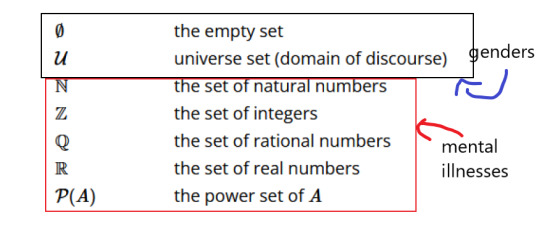#discrete math
Text


03.29.24~ Some unholy lvl modulo operations in an RSA decripting process, I rly think they need to start upping their game on these hw problems. The exam was ATLA themed but a JJK theme 🫶
A good linear one could be:
*Sukuna killed approximately 287^5 individuals in Harajuku last Thursday please calculate the volume of his domain in millimeters cubed if the radius spanned a vector that could be written as (1,8,9)*
Bonus: *what’s the population density of this region?*
#I would kms#academia#studyblr#study#progress update#light academia#student#studying#notes#discrete math#discrete#linear#linear algebra#jujutsu kaisen#jjk#jjk sukuna#sukuna#domain expansion#university#college#university student#uni
9 notes
·
View notes
Text
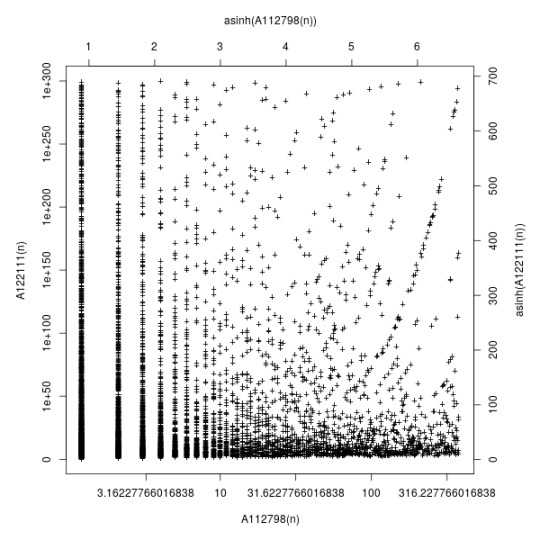
A112798: Table where n-th row is factorization of n, with each prime p_i replaced by i. vs A122111: Self-inverse permutation of the positive integers induced by partition enumeration in A112798 and partition conjugation.
#weirdcore#cybercore#webcore#core aesthetic#glitchcore#computercore#math#mathematics#maths#STEM#computer#computer science#graph#graphs#graph theory#sequence#OEIS#sequences#discrete math#discrete mathematics
33 notes
·
View notes
Text
hello peoples, I present math / theoretical cs problem,
what is the maximum length binary string such that each string of length k is unique?
the inspiration is that I wanted to make like a precise track thingy that can move around and I was thinking how to determine the position,
like if the above is v big and generatable I can engrave that on the track and use a camera to look down and calculate the position

I have an upper bound for the length 2^k + k - 1 cause there's only so many patterns but other than that idk
36 notes
·
View notes
Text
(from June 2023)
Note: In runtime formulas, computer scientists don't ignore the constant term because it "doesn't have a big effect". They ignore it because they're trying to establish an upper bound for problems of every size. (This is a common misconception about the big-O notation used in computer science.)
21 notes
·
View notes
Text
would anyone be interested in an upper level mathematics discord? I know there's math and hw servers out there but I was thinking it may be nice to help each other with let's say everything past precal ?
#mathblr#server#studying#studyblr#calculus#mathematics#number theory#discrete math#statistics#studyspo#math community#fractals#proofs
9 notes
·
View notes
Text


not my fav but discrete mathematics is still nice + the views here are pretty, in a few days I'll be back in the heat of the city where I go to university for this one exam and I'm not exactly excited
16 notes
·
View notes
Text
Please, do not hoard your examples of submodular and supermodular functions, please share them with me.
2 notes
·
View notes
Text
Day 1/50

Spring term of my first year at uni started this week. I had a day off today. I went on a study picnic in our hostel park with my roommate ( @studyingisfunmedh ).
Made notes for Discrete Mathematics and revised what was taught so far. Looking forward to immerse myself in the beauty of learning and studying for this fresh new semester. <3
#50 days productivity challenge#studyblr#studyspo#productivity#studying#aesthetic#dark academia#dark acadamia aesthetic#discrete math#computer science#btech cse#lpu
15 notes
·
View notes
Text
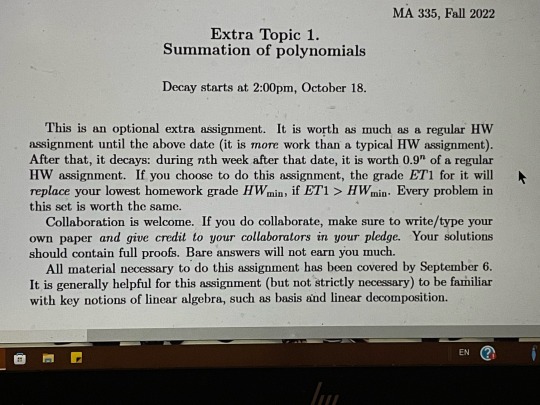
when your professor writes the instructions in math
26 notes
·
View notes
Text
This cool puzzle is exercise 14 in "102 Combinatorial Puzzles" by Titu Andreescu and Zuming Feng
Suppose you have a finite number of cards. Each card has a nonempty list of distinct names on it- different cards can share names, but each name appears at most once on each card. The cards are separated into a left pile and a right pile, with more cards in the left pile than in the right. For each name, we can do a "shuffle", which consists of moving all cards on the left stack that have that name to the right stack and vice versa. For example, suppose we have three cards and two names ("A" and "B"), configured like so:
AB
A B
Then the B shuffle would turn it into this:
B
A AB
Prove that there always exists a finite sequence of shuffles that ends with there being more cards on the right stack than on the left. Hints below!
I never said that the amount of names on each card has to be finite, but if it's not you can simply ignore all but a finite number of names on each card. Why?
Try reducing the problem to a simpler case. What happens if there's only one name? Two?
Induct, young Padawan.
5 notes
·
View notes
Text
my final exams are in two weeks…I have a final paper to write😳
planning to follow this study regimen to maintain some semblance of sanity:
Classical Greek:
review vocabulary every morning before classes get caught up on any missing homeworks (i have adhd sryyyyy), studying grammar in the process
Discrete Math:
Go through incorrect homework/exam problems every evening
Reading Writing War (an English seminar):
Finish and revise final paper Complete 4th credit project
Calculus:
Get caught up in the textbook Go through incorrect homework/exam problems every night Go to every study group/workshop
wish me luck 🕯🕯🕯
#dark academia#study#study goals#studyblr#neurodivergent student#university exams#Classical Greek#discrete math#English class#calculus#math major#stem
4 notes
·
View notes
Text
im sorry
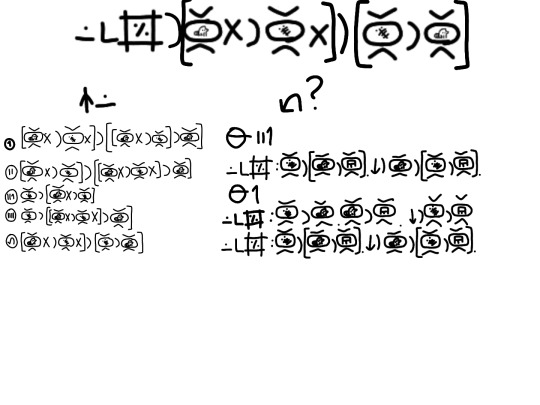
remind me to rewrite this in the latin alphabet (sitelen Lasina) tomorrow
edit:
lon pi nanpa kipisi la [ante K ala la ante P ala] la [ante P la ante K]
( discrete math theorem: (~K => ~P) => (P => K) )
nasin lon
proof
(wan) [ante K ala la ante P ala] la [[ante K ala la ante P] la ante K]
(1) ((~K) => (~P)) => (((~K) => P) => K)
(tu) [ante K ala la ante P] la [[ante K ala la ante P ala] la ante K]
(2) ((~K) => P) => (((~K) => (~P)) => K)
(tu wan) ante P la [ante K ala la ante P]
(3) P => ((~K) => P)
(tu tu) ante P la [[ante K ala la ante P ala] la ante K]
(4) P => (((~K) => (~P)) => K)
(luka) [ante K ala la ante P ala] la [ante P la ante K]
(5) ((~K) => (~P)) => (P => K)
tan seme
why
(wan) lawa tu wan
(1) Axiom 3*
(tu) lon pi nanpa kipisi: ante P la [ante K la ante L]. ni la ante K la [ante P la ante L]
(2) discrete math theorem: ( P => (K => L) ) => ( K => (P => L))
(tu wan) lawa wan
(3) Axiom 1
(tu tu) lon pi nanpa kipisi: ante P la ante K. ante K la ante L. ni la ante P la ante L.
(4) discrete math theorem: P => K, K => L ⊢ P => L
(luka) lon pi nanpa kipisi: ante P la [ante K la ante L]. ni la ante K la [ante P la ante L]
(5) discrete math theorem: ( P => (K => L) ) => ( K => (P => L))
*so i went on Wikipedia to see if axiom numbers used in my class match up with what people usually use, and i found out that thing i was proving (i.e. contrapositive) is axiom 3 according to Wikipedia. however, in my class, axiom 3 is
"((~p)=>(~q)) => (((~p)=>q)=>p)"
so uh... yeah for the purposes of this post, ^ is axiom 3
#look i just got into toki pona like 2 days ago#toki pona was NOT meant for math#yet i did it anyway#toki pona#discrete math#math
3 notes
·
View notes
Text
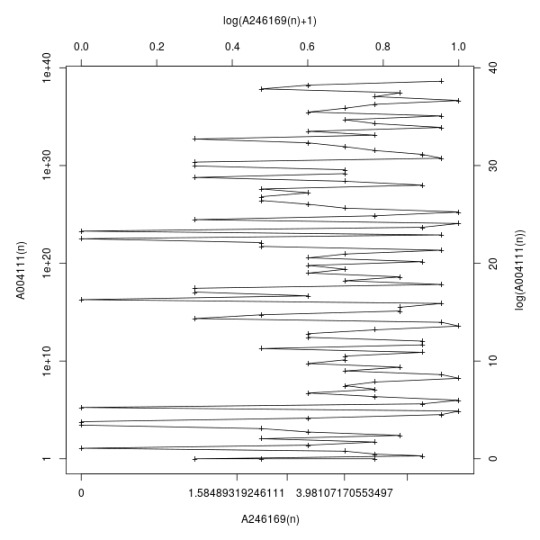
A246169: Decimal expansion of a constant related to identity trees vs A004111: Number of rooted identity trees with n nodes (rooted trees whose automorphism group is the identity group).
#weirdcore#cybercore#webcore#glitchcore#core aesthetic#computercore#math#mathematics#sequence#computer science#oeis#STEM#maths#graph theory#discrete mathematics#discrete math#graph
10 notes
·
View notes
Text


doodlin 24 in class
1K notes
·
View notes
Text
https://www.quantamagazine.org/finally-a-fast-algorithm-for-shortest-paths-on-negative-graphs-20230118
(from January 2023)
0 notes
